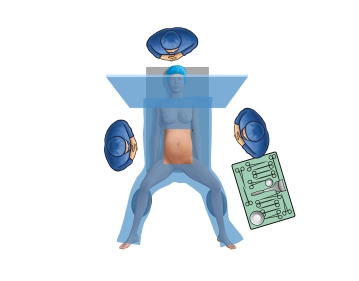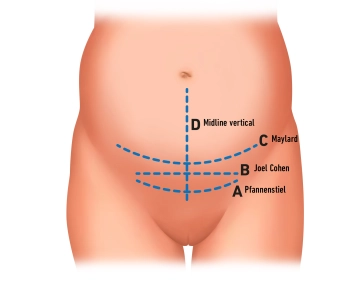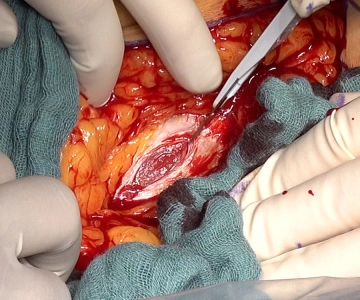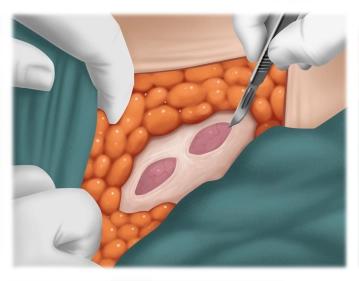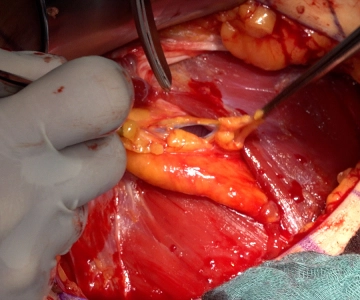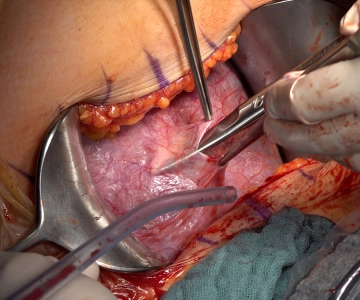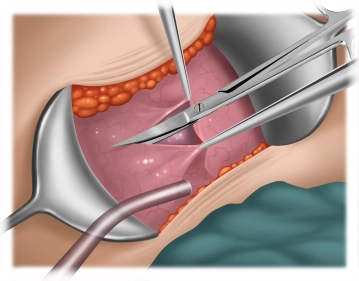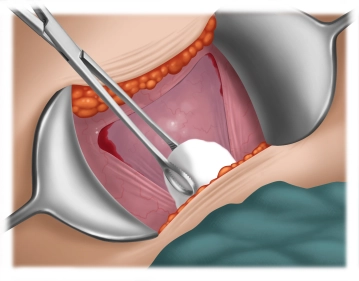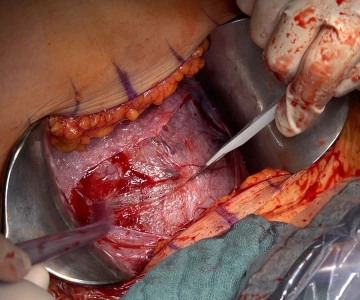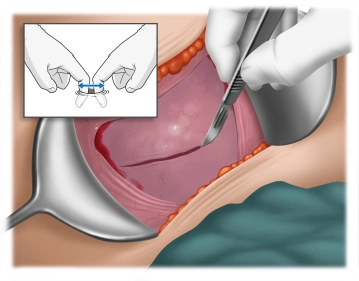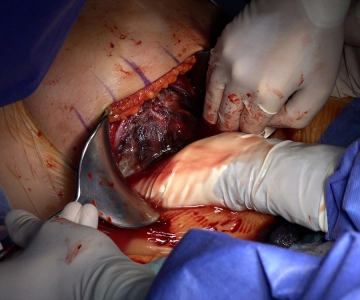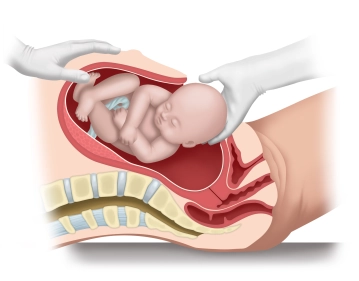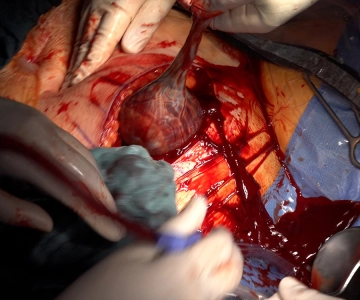- The patient is positioned in the supine position
- Legs slightly bent:
The legs were slightly bent and the knees supported with a soft pad to ensure a comfortable position and avoid muscle tension. - Arms positioned:
Both arms are extended and padded, which is important for the administration of intravenous medications and fluids. - Head and neck support:
The patient's head was placed on a soft, ergonomic pillow to support the natural curvature of the cervical spine. - Thermoregulation:
To prevent hypothermia, the patient was covered with a warmed cloth or thermal blanket, while the surgical field remained sterilely exposed. - Urinary catheter:
Before the start of the surgery, a transurethral urinary catheter was inserted to empty the bladder and minimize the risk of injury during the uterotomy.
-
Positioning
![Positioning 1]()
![Positioning 2]()
-
Marking incision line
![Marking incision line]()
Soundsettings After positioning and disinfecting the patient, the planned incision line in the suprapubic region was marked. This typically involved the Pfannenstiel incision, a transverse skin incision approximately 2–3 cm above the symphysis.
The marking is done using a sterile skin marker. With the help of a ruler or scale, the length of the planned incision (approximately 10–15 cm, depending on anatomical conditions) was measured and marked.
-
Opening of the abdominal wall
![Opening of the abdominal wall 1]()
![Opening of the abdominal wall 2]()
Soundsettings Skin Incision:
- The skin is incised transversely with a scalpel along the marked line. The depth of the cut is measured so that only the skin is transected.
Subcutaneous Tissue:
- After the skin incision, the underlying subcutaneous tissue is opened centrally over a length of approximately 2-3 cm.
Fascia:
- The underlying fascia is also opened on both sides of the midline over approximately 2 cm.
Now, the subcutaneous tissue and fascia are bluntly expanded laterally, followed by traction in the cranial-caudal direction.
The muscles of the rectus abdominis are bluntly separated (in the midline) to expose the underlying peritoneum.
-
Opening Peritoneum
![Opening Peritoneum]()
Soundsettings Grasp the parietal peritoneum with 2 forceps and sharply open it with scissors.
Alternatively: Blunt dissection with the index finger until a hole is created.
After opening the peritoneum, it is bluntly expanded in a cranio-caudal direction.
Insertion of 2 Fritsch wound hooks and expansion of the access path by lateral traction.
-
Preparation of the urinary bladder
-
Uterotomy
![Uterotomy 1]()
![Uterotomy 2]()
Soundsettings After mobilizing the bladder, the lower uterine segment becomes visible. A small transverse incision is made in the midline of the lower uterine segment with a scalpel, taking care not to injure the fetal structures. Then, by entering with the index fingers and applying lateral traction, the hysterotomy is expanded.
After sufficient opening of the uterus, the amniotic sac is deliberately opened with fine scissors or forceps.
-
Child delivery/extraction
![Child delivery/extraction 1]()
![Child delivery/extraction 2]()
Soundsettings Placing the hand under the infant's head and gentle pressure on the uterine fundus by the assistant. Through a controlled levering motion, the head is slowly delivered outward. After the head is delivered, the anterior and posterior shoulders are carefully delivered under direct vision. The rest of the child's body (torso, pelvis, and legs) usually follows easily from the uterus.
The umbilical cord is clamped twice and cut in between. If desired by the parents or for medical indication, Delayed Cord Clamping is performed for a few seconds to minutes. However, attention must be paid to bleeding from the hysterotomy.
-
Retrieval of the placenta and fetal membranes
![Retrieval of the placenta and fetal membranes]()
Soundsettings After the development of the child, uterotonics (e.g., oxytocin) are administered to promote uterine contraction and thus the physiological separation of the placenta.
A controlled cord traction technique is preferably used to atraumatically deliver the placenta and minimize the risk of postpartum complications, particularly endometritis and uterine injuries.
In this process, the uterus is manually palpated through the abdominal wall, with controlled, gentle traction on the umbilical cord to slowly draw the placenta towards the incision.
In some cases, however, manual removal of the placenta is necessary, where the surgeon inserts their hand into the uterus and carefully detaches the placenta from the uterine wall.
The uterus is completely exteriorized onto the sterile abdominal wall, making the uterine incision
Activate now and continue learning straight away.
Single Access
Activation of this course for 3 days.
Most popular offer
webop - Savings Flex
Combine our learning modules flexibly and save up to 50%.
US$51.56/ yearly payment
gynecology
Unlock all courses in this module.
US$103.10 / yearly payment



